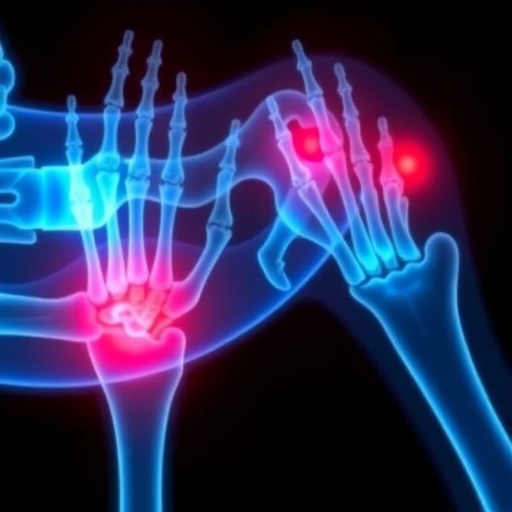Peripheral Nerve Signaling Emerges as a Novel Therapeutic Avenue to Halt Osteosarcoma Growth and Alleviate Pain
In a groundbreaking study published in the prestigious Proceedings of the National Academy of Sciences (PNAS), neuroscientists and oncologists from Johns Hopkins Medicine and collaborating institutions have unveiled compelling evidence that inhibiting peripheral nerve signaling significantly impairs the progression of osteosarcomas—malignant bone tumors notorious for their aggressive nature and excruciating pain. This discovery highlights a fascinating, previously underexplored relationship between the nervous system and tumor biology, offering hope that FDA-approved analgesic drugs could be repurposed as innovative anti-cancer therapies.
The research focuses on peripheral afferent neurons, specialized nerve fibers responsible for transmitting sensory information from body tissues to the central nervous system. These neurons are known to invade osteosarcoma tumors, where their interaction creates a microenvironment that not only exacerbates pain but also supports tumor innervation and angiogenesis, fostering unchecked malignancy growth. Using sophisticated murine models genetically engineered to suppress key neuron growth pathways, the study uncovers the pivotal role played by proteins—nerve growth factor (NGF), its receptor tropomyosin receptor kinase-A (TrkA), and calcitonin gene-related peptide (CGRP)—in mediating this pathological crosstalk.
The authors demonstrate that pharmacological blockade of NGF-TrkA signaling via the application of bupivacaine and rimegepant—drugs already sanctioned by the FDA for nerve pain and migraine management, respectively—substantially diminishes tumor-associated nerve sprouting as well as the vascular networks vital for tumor sustenance. This suppression not only alleviates the debilitating pain affecting osteosarcoma patients but crucially retards tumor proliferation and metastatic dissemination. The findings redefine the therapeutic landscape, underscoring the potential of targeting peripheral neurobiology to combat bone cancer.
Intriguingly, the team’s previous research had established that enhancement of NGF-TrkA signaling facilitates bone fracture repair by promoting nerve and blood vessel growth. This new study, however, reveals a paradox wherein the very pathway that aids skeletal healing becomes hijacked by malignant cells to foster their expansion. Aaron James, M.D., Ph.D., senior author and professor of pathology at Johns Hopkins, emphasizes that therapeutic strategies must therefore be context-dependent, shifting from stimulation in regenerative settings to inhibition in oncogenic ones.
Using genetically modified mice lacking functional TrkA signaling in sensory neurons, the team showed a marked reduction in tumor innervation and angiogenesis compared to controls. These TrkA-deficient mice exhibited slower tumor growth rates and extended survival, reinforcing the causal link between peripheral nerve activity and osteosarcoma pathogenesis. Beyond the neural landscape, the study noted a concomitant decline in tumor-associated macrophages—immune cells that contribute to a pro-tumor microenvironment by suppressing immune responses and aiding resistance to chemotherapy.
Human tumor samples echoed the murine findings by displaying increased expression of NGF-TrkA signaling components correlated with extensive nerve and vessel growth within osteosarcomas. This correlation validates the translational relevance of the mouse model and supports the notion that peripheral nerves actively shape tumor behavior in patients. Further analysis of dorsal root ganglion neurons — integral to relaying sensory signals from peripheral tissues — from individuals experiencing tumor-related pain revealed elevated CGRP activity alongside inflammatory markers, reinforcing the signaling axis as a candidate for therapeutic intervention.
Building upon these insights, the researchers administered bupivacaine and rimegepant to their osteosarcoma-bearing mice, observing significant reductions in neural and vascular tumor infiltration. These drugs, by disabling CGRP and NGF-TrkA signaling pathways, disrupt the neuron-to-tumor communication loop that amplifies malignancy. Consequently, treated mice manifested reduced tumor burden and decreased nociceptive behavior, suggesting dual benefits in cancer control and pain management.
The study’s revelation that peripheral sensory neurons are indispensable components in osteosarcoma development and symptomatology shifts paradigms in cancer biology. It unites neurobiology with oncology in a deeply mechanistic framework, illustrating how tumors co-opt physiological nerve signaling pathways to orchestrate their own growth niches. Future research aims to delineate the molecular underpinnings of neuron-tumor interactions further, potentially identifying new molecular targets alongside TrkA and CGRP to interrupt this pathogenic dialogue.
Funding for this research was provided by an extensive array of federal sources including multiple grants from the National Institutes of Health—specifically the National Institute of Arthritis and Musculoskeletal and Skin Diseases, National Institute of Neurological Disorders and Stroke, and the National Institute of Dental and Craniofacial Research—as well as support from the Department of Defense and prominent cancer and stem cell research foundations. Collaborative contributions extended across Johns Hopkins, Memorial Sloan Kettering Cancer Center, University of Maryland, University of Texas at Dallas, University of Texas Southwestern, and University of Wisconsin-Madison, embodying a truly multidisciplinary approach.
Beyond its scientific novelty, this work carries profound clinical implications. Current osteosarcoma treatments often involve aggressive surgical interventions and chemotherapy with limited success against metastatic disease and nerve pain. By repurposing already-approved medications that target nerve-cancer interactions, clinicians may soon have new tools to both stanch tumor growth and improve quality of life for patients suffering from severe cancer-induced pain. This study thus paves the way for translational efforts aiming to bridge basic discoveries with concrete therapeutic strategies.
Ultimately, the research underscores the intricate interplay between the nervous system and cancer biology, revealing peripheral neurons as key facilitators of malignancy rather than mere bystanders. By targeting this critical nexus with analgesic drugs, the field may witness the emergence of novel, less toxic therapeutic paradigms that leverage the body’s own signaling machinery to combat cancer.
Subject of Research: Interaction of peripheral sensory neurons with osteosarcoma tumor growth and associated pain mechanisms
Article Title: Peripheral sensory nerve signaling blockade impedes osteosarcoma growth and relieves tumor-associated pain
News Publication Date: October 28, 2025
Web References: https://doi.org/10.1073/pnas.2500161122
Image Credits: Sowmya Ramesh, Johns Hopkins Medicine
Keywords: Cancer, Bone cancer, Osteosarcoma, Peripheral nerves, NGF-TrkA signaling, Calcitonin gene-related peptide, Tumor innervation, Angiogenesis, Pain management, Bupivacaine, Rimegepant




